Owner City of Regina Architect Unknown Opened 21 October 1936 | Closed November 5, 2016 Capacity 30,048 Team Saskatchewan Roughriders | |
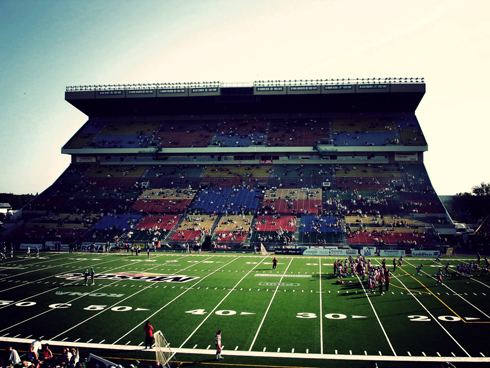 | ||
Former names Park de Young (1936–1946)
Taylor Field (1947-2005)
Mosaic Stadium at Taylor Field (2006-2016) Location 1910 Piffles Taylor Way
P.O. Box 1966
Regina, Saskatchewan
S4P 3E1 Surface Dirt (1936–1946)
Grass (1946–1978)
3M Tartan Turf (1979–1987)
OmniTurf (1988–1999)
AstroTurf (2000–2006)
FieldTurf (2007–2016) | ||
Mosaic Stadium at Taylor Field is an open-air sports stadium located in Regina, Saskatchewan, which was used primarily to play Canadian football. It was the full-time home of the Canadian Football League's Saskatchewan Roughriders from its initial establishment as complete stadium in 1936 until 2016, although the team was playing some of its games at the site as early as 1921. Originally designed to house baseball as well as football, the stadium was converted to a football-only facility in 1966.
Contents
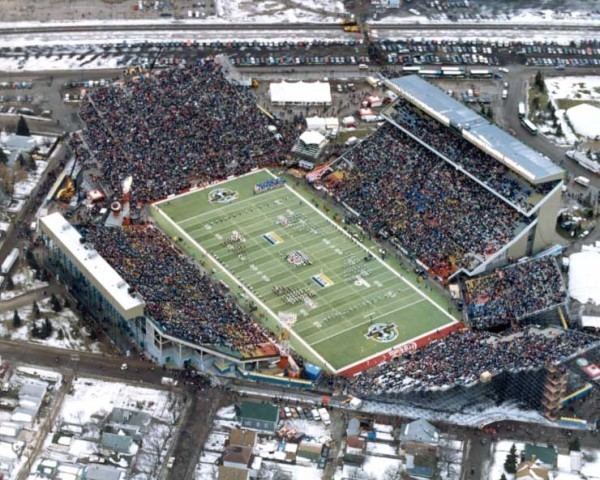
Mosaic Stadium at Taylor Field was also the home field for the University of Regina Rams, who play in U Sports' Canada West conference, the Regina Thunder, who play in the Canadian Junior Football League; and the Regina Riot of the Western Women's Canadian Football League. The field was also used to play high school football. It is owned and managed by the city of Regina. The field is artificial turf and, as of 2012, a seating capacity of 32,848.
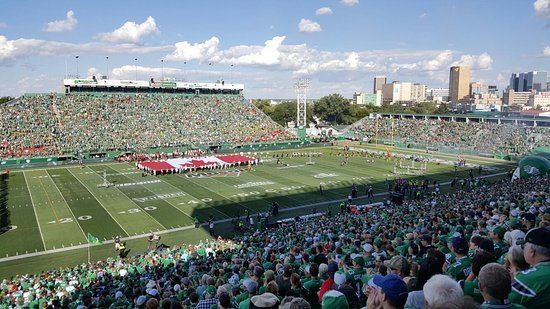
The stadium closed after the 2016 season, as the new Mosaic Stadium was completed in 2016, and will become the Roughriders' home field beginning in 2017. The old stadium is currently slated to be demolished with the site being converted into a mixed use development.
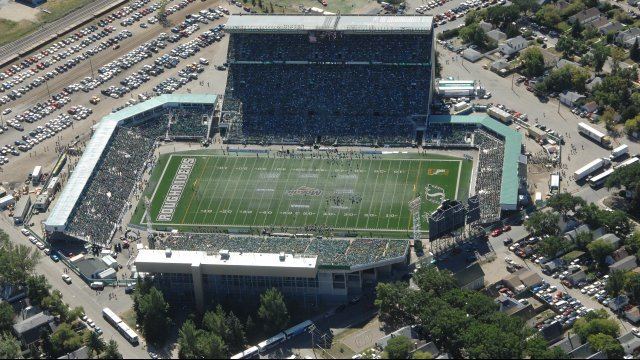
History

The stadium is located in the North Central portion of Regina. Beginning in 1910, the original Regina Rugby Club played at various venues throughout the city, including Dominion Park and Exhibition Park. In 1921, the team began playing at a soccer field known as Park Hughes, which is located where the stadium still stands today.
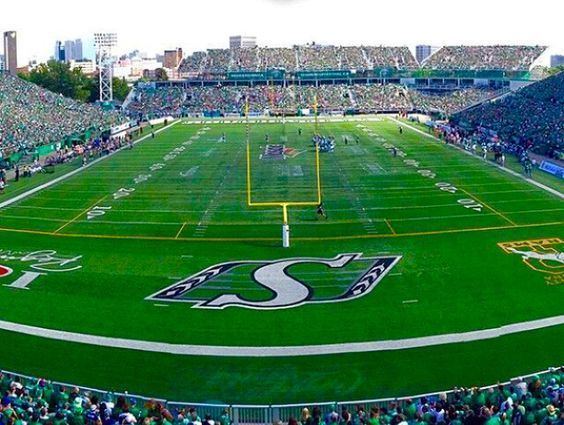
In 1928, Park Hughes and an adjoining baseball diamond known as Park de Young were reconfigured to provide a better venue to accommodate the growing number of baseball and football fans. To make the facility suitable for both sports, the football field was laid out in a unique diagonal pattern, a configuration which would persist throughout the remainder of the facility's existence.
Nevertheless, the venue's facilities remained rudimentary even by contemporary standards. Often, heavy rain would turn the dirt playing surface to mud and the team was compelled to relocate games to other venues in the city, including the RCMP barracks. At the time, the barracks housed a unit informally called the Roughriders who were tasked with breaking in wild broncos for the force. In 1924, the Regina Rugby Club would adopt the Roughriders nickname as their own.
After the first permanent grandstand was built in 1936, the team moved into the facility full time and remain there for the next eight decades. However, for a decade after the first permanent seating was built the playing surface remained plain dirt, with a new layer of topsoil added every year. Late-season games were frequently played in dust bowl conditions. Finally, in 1946, the city recreation board agreed to plant a more stable grass surface.
In 1947 the facility was renamed Taylor Field after recently deceased Neil J. "Piffles" Taylor, a First World War fighter pilot and postwar lawyer who played and coached rugby union and football in the city, and subsequently served as president of the Regina Roughriders, the Canadian Rugby Union and the Western Interprovincial Football Union. A man of legendary toughness, Taylor lost an eye in action during the First World War, and spent more than a year in a German prisoner of war camp, but persisted in playing football in the 1920s. His artificial glass eye was once jolted out of its socket when he was tackled. All play stopped while players from both teams hunted for the missing eye. When found, Taylor cleaned it, then popped it back into its socket and resumed play.
Renovations in 1978-79 increased the seating capacity by about 7,000 seats with the addition of an upper-level grandstand on the west side of the stadium, in addition, the stadium gained an artificial turf surface which replaced the natural grass surface previously used. In 2005, a new scoreboard was installed, which included the stadium's first permanent giant replay screen.
Former Rider receiver Hugh Campbell said in the documentary CFL Traditions in 2003. "When I first saw the stadium in Regina (in 1963), it looked like a farmer had built it, you know, like they'd just added on a few pieces here and there and half of the dressing room was dirt floor, where us rookies got to be. But we had a hook for everybody to hang their clothes on so that was a pretty good deal."
On June 23, 2006, the Roughriders and The Mosaic Company announced a 10-year, $3.75 million naming rights deal. Unlike other similar deals, which have seen original names of facilities disappear, it was decided to retain the Taylor Field name, thus the facility was renamed Mosaic Stadium at Taylor Field.
Upgrades
In 2005, Mosaic Stadium gained refurbished washrooms, concessions and refurbished seats on the east side, a new sound system, and the new SaskTel MaxTron video board. In 2006, a VIP deck and stands were put in place in the south endzone, allowing the football club to host its corporate game day sponsors. In 2007, the field was switched to use FieldTurf—Mosaic was the second-to-last stadium in the CFL to still use AstroTurf.
On July 31, 2008, the Roughriders announced that temporary seats would be added to the stadium due to high demand for tickets—the team had sold out every home game for the 2008 season. With tickets in high demand coming off their Grey Cup season, an extra 2,145 seats were added, bringing the capacity to 30,945. The seating was first put to use during the Labour Day Classic against the Winnipeg Blue Bombers. Following the 2008 West Semi-Final game on November 8, 2008 against the BC Lions, the temporary seats were taken down, putting the capacity back to the original number of 28,800. 2,145 temporary extra seats were put in place for 2009 season. Temporary seating was again put in place for the 2010 season; however, the additional seating only raised capacity to 30,048.
On February 24, 2012, the Roughriders announced a $14 million renovation plan known as the "Legacy Project" to prepare the stadium for hosting the 101st Grey Cup. The first stage of the renovations were finished in time for the start of the 2012 season, with the addition of 7,000 extra seats and 27 new corporate suites (arranged to give the stadium a more "bowl"-like feel), additional bathrooms and concessions, the SaskTel MaxTron video screen and scoreboard upgraded to a 60-foot LED screen (with a second display directly alongside, shaped like the province of Saskatchewan), a new 55-foot video screen attached to the west grandstand, and ribbon screens along the bottom of the grandstands. For the 2013 season, its capacity was expanded to 45,000 with temporary seating, which were removed for the following season.
Football and other sports
Concerts
Replacement
On July 12, 2012 during a pre-game ceremony, Premier of Saskatchewan Brad Wall and Regina mayor Pat Fiacco announced that a new stadium would be constructed for the Roughriders at Regina's exhibition grounds. With an estimated budget of $278 million, the new Mosaic Stadium will seat 33,000, and be completed by in time for the 2017 CFL season in June 2017.
Taylor Field hosted its final Roughriders game on October 29, 2016. The following week, it hosted its final football game, a Canada West conference semi-final with the Regina Rams.
